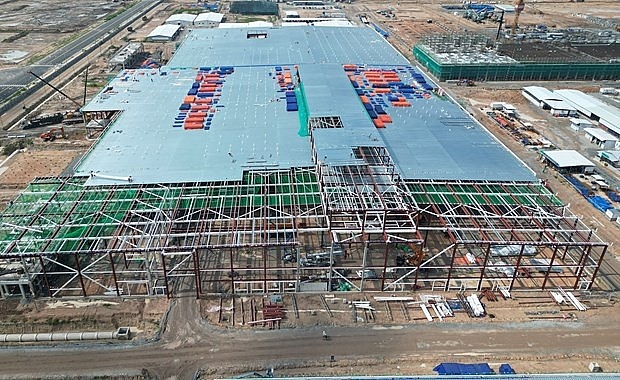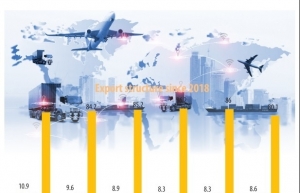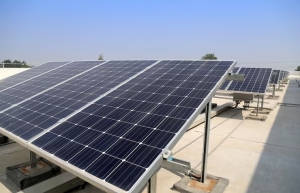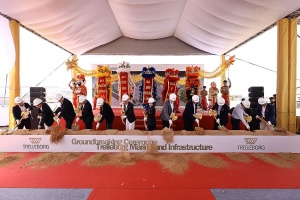IP developers hungry for financial bankroll
 |
| Part of the LEGO factory under construction in the Vietnam-Singapore Industrial Park III in Binh Duong province (Published by VNA) |
The interim executive committee of the Vietnam Industrial Park Finance Association (FAIP) was recently launched in Hanoi.
One of the key missions of the FAIP, which is a member of the Vietnam Financial Consulting Association (VFCA), is to become a trusted focal point for investors and partners, connecting supply and demand in terms of finance for organisations and individuals operating in industrial parks (IPs).
In addition, it will represent the IP developer community to advise state management agencies in building relevant policies, while advising the VFCA in consulting and social appraisal activities.
According to the VFCA, the new entity is necessary in the context that demand for capital from industrial real estate developers is large.
According to Vietnam’s land use planning strategy, by 2030 the land area for IP development will reach almost 211,000 hectares. Thus, from now to 2030 there will be about 120,000ha of IPs, of which the area of industrial land for rent is about 80,000-85,000ha.
According to a survey by the Institute for International Investment Studies, the current average estimated investment cost to develop one hectare of IP land is about $600,000. The need for capital to develop infrastructure in IPs before 2030 and carry out construction is about $72 billion.
If the average investment rate of $6.5 million per ha of industrial land is taken into account, the need to attract investment capital to fill the remaining area of Vietnam’s planned IPs is about $600-650 billion.
In a report summarising 30 years of industrial and economic zone development by the Ministry of Planning and Investment, the government agrees that by 2030, up to half of localities will have plans to convert existing parks to eco-IPs, and 8-10 per cent of localities will plan to build new eco-IPs.
Large real estate corporations are seeking foreign rather than domestic capital because the latter market remains cool.
The capital demand is large and capital resources for green economic development in general and eco-IPs in particular are still very limited, according to Le Minh Nghia, chairman of the VFCA. The current financial policy system applied to Vietnam’s IPs only focuses on tax policy, land policy, investment incentive policy and other local support policies. Meanwhile, the role of credit policy is still relatively obscure.
“There are almost no preferential credit policies prescribed to promote capital access for IPs in general and eco-IPs. Without timely investment, it is very difficult for the eco-IP model to develop in reality, and this may cause Vietnam to miss the wave of green funding that is increasingly becoming a central trend of international investors,” said Nghia.
As of the start of 2023, the total outstanding green credit debt in Vietnam reached $20.37 billion, accounting for about 4.3 per cent of the total outstanding bank credit debt for the economy, according to VFCA statistics.
“State budget capital to support IP infrastructure development is still low compared to demand. In the medium-term public investment plan 2016-2020, the capital allocated to support IP infrastructure development only met half of the demand,” said Can Van Luc, chief economist of BIDV.
“It takes a long time to invest the IPs and recoup the capital, thus the industrial real estate developers depend heavily on credit capital and corporate bonds, so their need for medium and long-term loans is huge, which serve to clear land, rent land, build infrastructure,” Luc added.
| Ngo Cong Thanh, vice chairman Institute of International Investment Studies Industrial parks (IPs) and economic zones (EZs) have contributed positively to Vietnam’s growth and socioeconomic development achievements in recent times. The Ministry of Planning and Investment has set targets to pull in investment in IPs and EZs this decade. Total registered capital is expected to reach about $390-460 billion, of which domestic capital is about $110-130 billion, and foreign invest ment is the remainder. To reach these targets, we need to have available industrial infrastructure. Nevertheless, attracting investment to develop IPs and EZs has revealed limitations. For example, investors of IP infrastructure projects, due to limited financial capacity, have the mentality of waiting to find secondary investors before putting money into shared infrastructure in IPs. Meanwhile, foreign financiers want to have the premises and technical infrastructure immediately, and then decide to act. This struggle and waiting have caused many IPs to have low occupancy rates. In light of that situation, mobilising huge capital for IPs in the coming years requires fundamental changes in opening up capital flows, creating stronger conditions to access production factors, and innovation in promotional activities. Ranjit Thambyrajah, chairman Acuity Funding Acuity is currently working on many IP projects in the world, including more than five projects in Vietnam that are at various phases of their development. These projects include a completed and operating park requiring refinance, and a few half-built infrastructure projects on partly cleared sites requiring more money to complete. Vietnam is currently lacking the diversified financial products and specialised services needed for the growth it is experiencing. The country needs long-term and large-scale funding, and it also needs progressive credit policies that are user-friendly to the developers and their projects. We mainly arrange senior debts from $100 million to billions of US dollars, with a 60 per cent lending ratio on improved valuation. When needed, we can also assist with sourcing preferred equity participants to assist good projects that need equity to qualify for our loans. On occasions, we can also consider alternative forms of equity and/ or serviceability, for example, bank guarantees, future purchase contracts, lease agreements, and recognition of pre-sales. Our typical loan terms are 20-40 years, including a 3-5 year grace periods from payments. This is a much-needed credit policy for Vietnamese developers and will help make their projects safer, profitable, and successful. |
| PM visits northern region's first semiconductor chip factory in Bac Giang Prime Minister Pham Minh Chinh on December 23 visited Hana Micron Vina Ltd., a company invested by the Republic of Korea (RoK) and the first semiconductor chip manufacturer in the northern region, which is located in Van Trung industrial park, Viet Yen district , the northern province of Bac Giang. |
 | Industrial development gains from cross-border investment Further economic integration has enabled Vietnam to improve the quality of industrial development, with a lion’s share created by foreign investment, helping to ameliorate the nation’s export structure. |
 | Industrial parks seek answers for potential power shortages Many industrial areas face the risk of power shortages in 2024, which will undermine production, tenants, and investment. |
 | Trelleborg breaks ground on manufacturing facility in Phu My 3 Specialised IP On January 16, Trelleborg Marine & Infrastructure broke ground on a new manufacturing facility in the Phu My 3 Specialised Industrial Park (IP) in the province of Ba Ria-Vung Tau. |
What the stars mean:
★ Poor ★ ★ Promising ★★★ Good ★★★★ Very good ★★★★★ Exceptional
Related Contents
Latest News
More News
- Global partnerships key to Vietnam’s IFC development (December 26, 2025 | 16:18)
- Vingroup pulls out of bid to invest in North-South high-speed railway (December 26, 2025 | 11:42)
- Strengthening supply chains through trade promotions and customs reform (December 24, 2025 | 14:00)
- PM orders investment model for North–South high-speed rail (December 22, 2025 | 17:43)
- LS Eco Energy to invest in Vietnam rare earth sector (December 22, 2025 | 17:31)
- Government moves to establish International Financial Centre (December 21, 2025 | 21:00)
- Vietnam's IFC to target global investment flows (December 21, 2025 | 18:00)
- Two national hospitals expand capacity with new facilities (December 20, 2025 | 09:00)
- Ha Tinh breaks ground on major Vingroup industrial and energy projects (December 19, 2025 | 18:24)
- EVN launches major power infrastructure projects nationwide (December 19, 2025 | 18:17)

 Tag:
Tag:





















 Mobile Version
Mobile Version